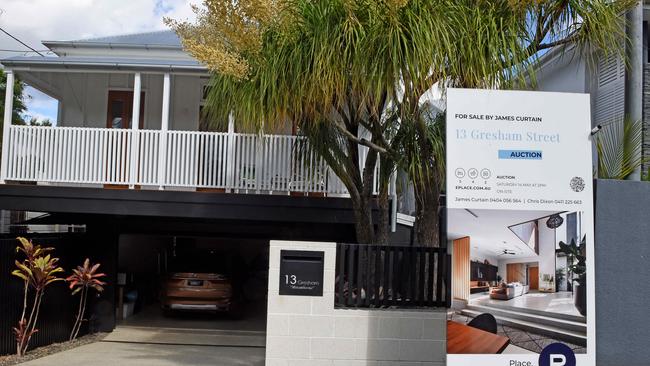Interest rate rises present billion-dollar problem for homeowners
Interest rates are certain to rise multiple times this year – and there’s a big problem looming for millions of homeowners.
Interest Rates
Don't miss out on the headlines from Interest Rates. Followed categories will be added to My News.
At least $44 billion worth of fixed rate loans are expiring in 2022, with homeowners facing having to fork out thousands more to pay off their mortgages.
Aussie homeowners were dealt a massive blow, with the Reserve Bank of Australia raising interest rates for the first time in 11 years at the start of May – by 0.25 per cent to 0.35 per cent.
Multiple rate hikes are predicted for the rest of the year too, with predictions they could reach anywhere between 1.25 per cent and 2.5 per cent by December, meaning millions of home loan customers will have to navigate higher loan repayments.
But for those who previously fixed part or all of their home loans, the rising interest rate could deliver a double blow, as fixed periods of millions of loans come to an end.
Australia’s largest home loan lender, the Commonwealth Bank has around $19 billion worth of fixed rate loans that will expire in June this year, while a further $25 billion will finish up by late 2022, according to data from comparison website Canstar.
Then in 2023, almost $100 billion worth of fixed rate mortgages held with CBA will roll off their fixed term, it also found.
Stream more finance news live & on demand with Flash. 25+ news channels in 1 place. New to Flash? Try 1 month free. Offer ends 31 October, 2022 >

If interest rates go up by 1 per cent it would see close to 322,000 additional households experiencing mortgage stress, while a 3 per cent rise would result in 933,000 more households under mortgage stress, according to data from Digital Finance Analytics.
Aussies embraced fixed rate home loans more heavily since the pandemic hit.
ANZ senior economist Felicity Emmett said 15 per cent of people took on fixed rates back in 2019, but this jumped to 46 per cent in the middle of 2021 while the official rate was at a record low.
How much rate rises could cost
Canstar analysis of major bank fixed rates shows borrowers who locked in for two years in mid-2020 would likely be paying an average rate of 2.27 per cent. For those with a $500,000 loan, this would mean monthly repayments of $1916.
If they were to roll off their fixed term in July 2022, at which point the average variable rate among the majors is expected to reach 2.89 per cent, their monthly repayments would increase by $153 to $2069.
But it will be a bigger jolt for homeowners with a $500,000 loan who locked in the average two-year fixed rate of 2.10 per cent in January 2021 with monthly repayments of $1873.
If they roll off in January 2023, when the average variable rate is expected to reach 3.89 per cent, they’ll be facing a whopping $452 extra per month.

Canstar editor-at-large and money expert Effie Zahos said the “dream run” for homeowners is over.
“Homeowners have enjoyed a dream run over the past few years when it comes to mortgage interest rates, with many people locking in while rates were at record lows,” she said.
“However many home loan customers are now reaching the end of their fixed terms, during a time where interest rates are rapidly creeping back up again.
“These borrowers are now facing the prospect of higher interest rates, and in turn, higher repayments, which can place additional stress on the household budget.”
Borrowers who locked in for three years at the start of 2020 would be paying an average rate of 2.98 per cent and for a $500,000 loan, with monthly repayments at $2103.
Assuming the average big bank variable rate rises to 3.89 per cent by early 2023, this same borrower would see their monthly repayments rise by $231 to $2334.
Yet it’s a different story for homeowners who locked in for three years at the start of 2019, where the average fixed rate was 3.77 per cent.
A borrower with a $500,000 mortgage who locked in back then could pocket savings of up to $223 each month when their fixed rate expires, assuming the average variable rate among the major banks reaches 2.89 per cent by mid-2022.

What to do about rising interest rates
Ms Zahos said borrowers generally have a few different options when they come off a fixed rate.
“They can do nothing and pay a higher rate, or they can lock in again,” she said.
“Refinancing to a lower rate is usually the best option, with many of the best deals to be had with smaller lenders.”
Refinancing to a lower rate loan means seeing how your loan stacks up against the broader market and if there’s a better deal, switching to a new lender.
Reserve Bank figures show in February, the average variable rate on outstanding loans was 2.92 per cent, which is 0.43 per cent higher than the average of 2.49 per cent across new loans written in the month, Canstar found.
But homeowners with under 20 per cent equity who are looking to refinance may not get the best rates as it only applies if you borrow between 60 per cent to 80 per cent of your home’s market value.

However, Ms Zahos warned that people should calculate the full cost of refinancing.
“You’ll often be up for additional charges and fees, which can make or break a good deal,” she said.
“At the same time, be wary of lenders who haven’t passed on any rate hikes yet; it’s a fair bet to say this may be a headline rate to get you in, and they could hike rates in the future.”
There’s also one more choice – splitting your loan between fixed and variable.
For example, you might decide to fix 60 per cent of your loan, while leaving the remaining 40 per cent variable.
This can provide shelter from rate rises, while allowing you to benefit from the flexibility of a variable rate, however if variable rates fall, you won’t pocket the full savings on the fixed portion of your loan, according to Canstar.

Buyers scared off
Demand for mortgages also fell by 4.6 per cent in the first three months of the year, marking the first decline in more than two years according to the latest credit agency Equifax’s latest Quarterly Consumer Credit Demand Index.
Kevin James, general manager of advisory and solutions at Equifax, said the decline in mortgage demand suggests interest rate rises and uncertainty around the impact on the housing market has started to hit consumers.
“We anticipate demand to slow further as additional interest rate increases are expected in coming months,” he said.
“While states that have contended with surging house prices for some time – like Tasmania, NSW and Victoria – saw significant drops in mortgage demand this quarter, Queensland remained relatively resilient.
“This could be indicative of recent migration to the state by people from cities like Sydney and Melbourne, who were able to negotiate greater work/life flexibility during the pandemic.”
Originally published as Interest rate rises present billion-dollar problem for homeowners





